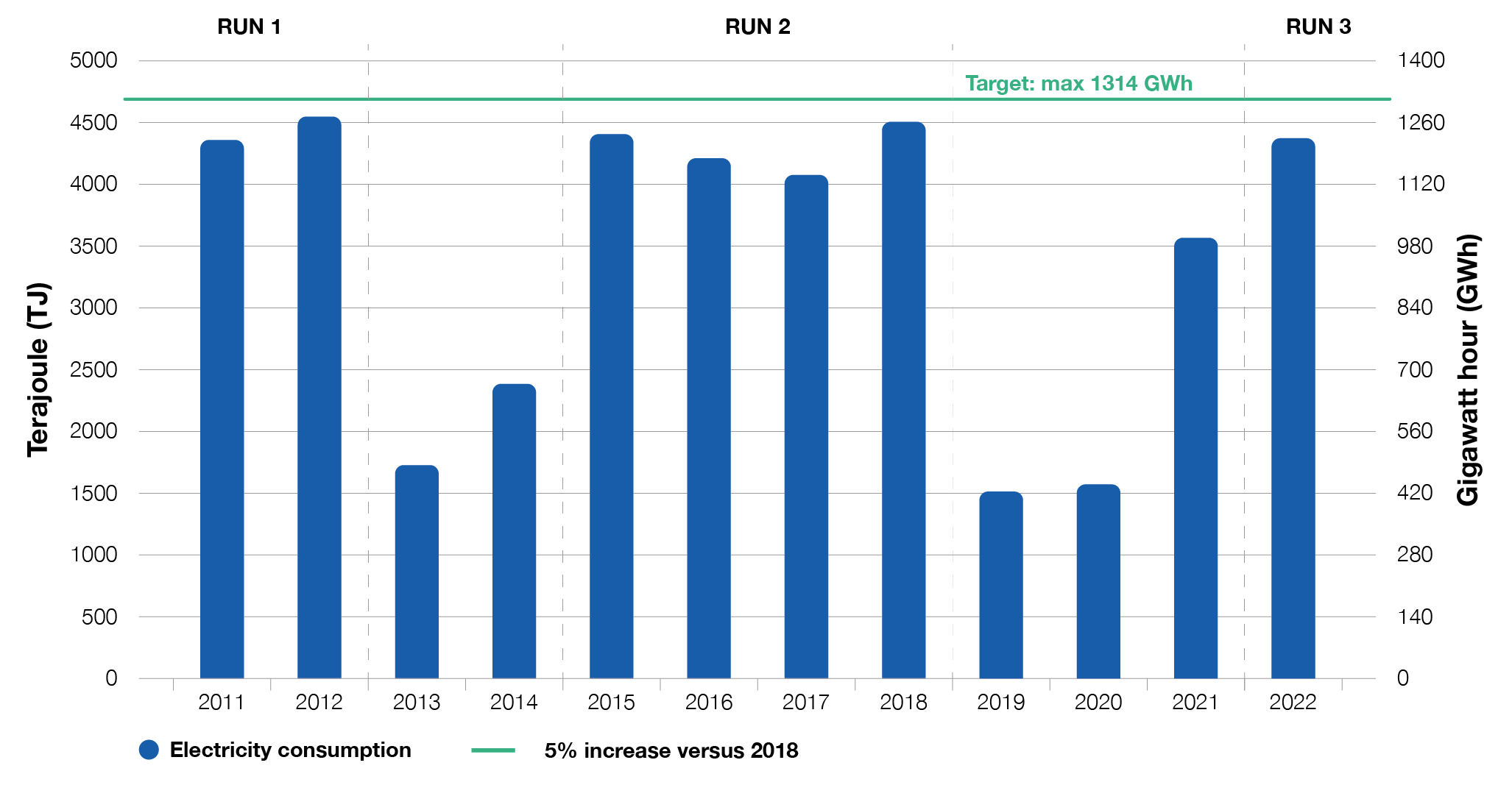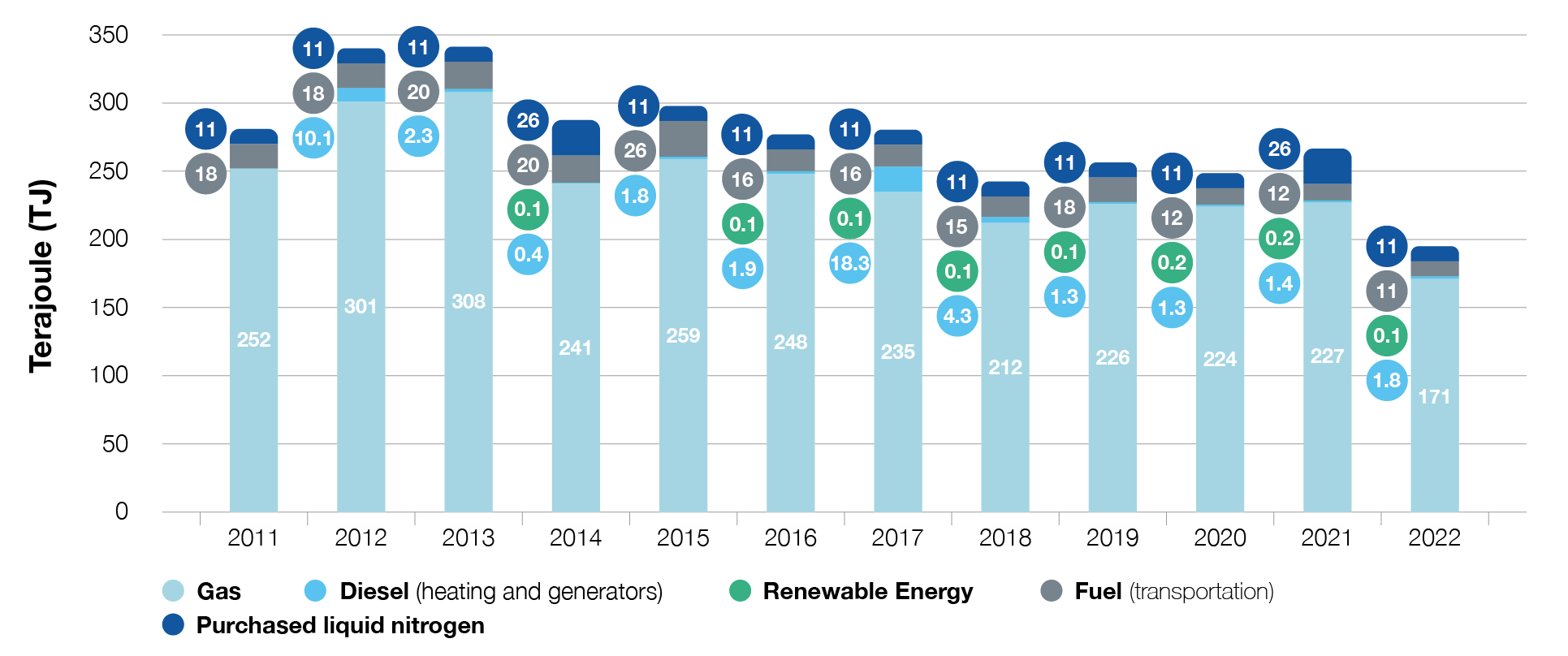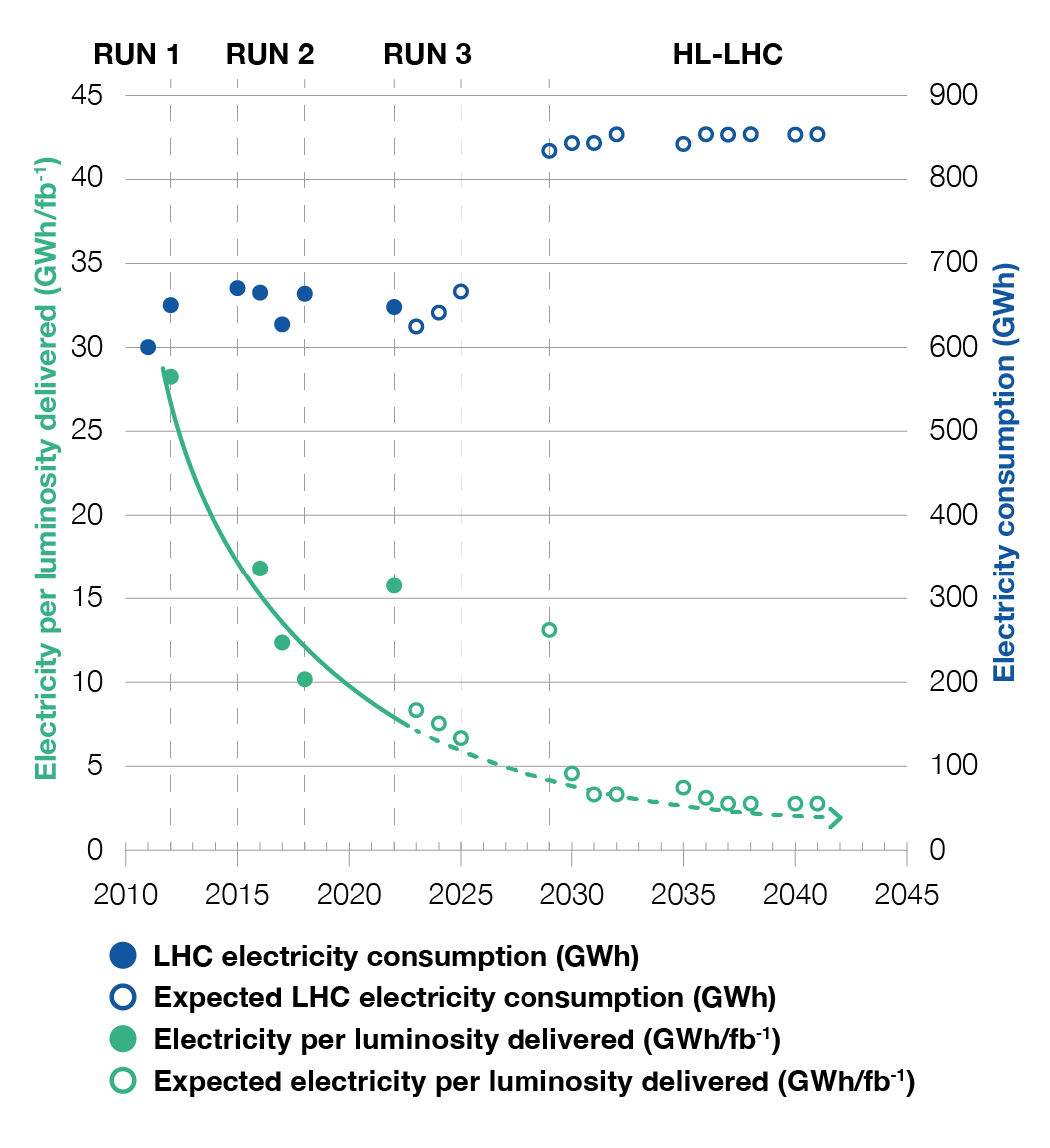Accelerators account for more than 90% of CERN’s energy consumption during run periods. As powerful research instruments, these machines make a unique scientific programme possible and support a global community of scientists. CERN makes every effort to run them in the most energy-efficient way possible, with its main immediate goal being to limit the increase in energy consumption up to the end of Run 3 to 5% with respect to 2018, despite the higher beam energy and intensity. The initial target date of 2024 to achieve this objective has been shifted in line with the change in the accelerator schedule, with Run 3 now expected to end in 2025.
POWERING UP FOR RUN 3
Powering CERN’s unique array of accelerators, detectors and infrastructure primarily requires electricity, which represents about 95% of CERN’s energy use. Under normal circumstances, this is procured entirely from France, where the energy grid mix is about 90% low-carbon (2022). CERN’s energy needs depend on annual accelerator operation cycles, peaking at some 1250 GWh/year during operation with beam, with the Large Hadron Collider (LHC) accounting for 55% of the total consumption. Following its second long shutdown, the LHC gradually resumed operations in 2021 and Run 3 was officially launched in July 2022. In 2021 and 2022, CERN consumed 995 GWh and 1215 GWh of electricity, respectively.

In addition to electricity, CERN also uses natural gas for heating, fuel for its fleet of vehicles and diesel for emergency generators. It also uses commercial liquid nitrogen for cooling and photovoltaic energy produced on site. In 2021 and 2022, CERN consumed 67 GWh (240 TJ) and 51 GWh (184 TJ) of fossil fuels, respectively. Energy procurement represents around 5% of CERN’s annual budget when the accelerators are running, and less during shutdown periods. This is expected to change markedly as of 2023, in light of the rising costs of energy worldwide.


CERN constantly strives to deliver more data to the experiments. At the LHC, this is measured using a parameter known as luminosity. Higher luminosity of the colliding beams leads to more data and increased potential for new discoveries, but can come at the cost of greater electricity consumption. CERN therefore aims to increase the energy efficiency of its facilities in terms of luminosity delivered per unit of energy consumed. The efficiency of the LHC in these terms increased by a factor of three between the start of Run 1 and the end of Run 2 and is expected to be multiplied by a factor of four in the High-Luminosity LHC (HL-LHC) era.
The energy intensity graph details the quantity of electricity used to run the LHC per unit of luminosity delivered, showing that less and less electricity has been needed over time to produce the same amount of data and, hence, scientific output. During the year after each long shutdown, while the machines are being brought back online and progressively ramped up, the luminosity delivered is not at its maximum – as seen in 2022 and 2029.
CERN’S ENERGY STRATEGY
The overarching principles of CERN’s energy strategy, guided by the Energy Management Panel (EMP) established in 2015, can be summarised in three key concepts : use less, increase efficiency and recover waste energy.
The EMP has driven major efforts to reduce electricity consumption through optimisation and dedicated actions, resulting in savings of some 100 GWh/year since 2010. The process of defining and agreeing upon longer-term objectives continues and these will be set out in future reports.
CERN began the process to obtain ISO 50001 energy management certification in 2022 (see In focus below). In this context, the Organization published an Energy Policy in October 2022, designed to continuously improve CERN’s energy performance by keeping the energy required for its activities to a minimum, improving energy efficiency and recovering waste energy. CERN’s Management led efforts to reinforce the existing frameworks for energy governance, in line with ISO 50001 requirements. A full-time energy coordinator was appointed, and the EMP was expanded to cover all of CERN’s activities beyond the accelerator complex
Energy diversification and heat recovery
CERN strives to further diversify its energy mix and, to that end, is looking to incorporate more renewable energy sources in the future. Various solutions are being investigated, such as power purchase agreements (PPA – contractual agreements between energy buyers and sellers). Studies and negotiations with potential suppliers have begun in order to explore concrete possibilities, notably with regard to photovoltaic energy for the Organization’s long-term requirements. More locally, solar panels installed on the new Science Gateway building, which is due to open in 2023, will inject unused photovoltaic energy into CERN’s grid.
In line with the priority to recover waste energy, the equipment that has been installed at LHC Point 8 to collect heat from CERN facilities to heat a residential area in neighbouring Ferney-Voltaire is ready to be connected. Two further heat recovery projects were approved during the period covered by this report. They aim to recover waste heat from CERN’s core activities, such as data processing, cooling and LHC operation, for reuse on the Meyrin and Prévessin sites. Their completion is anticipated in 2026–2027.
COMPUTING AND IT INFRASTRUCTURE
CERN’s main product is data, which is produced in particle beam collisions and recorded by the LHC experiments. This data is analysed on the WLCG, one of the world’s largest computing infrastructures, which is managed and operated by a worldwide collaboration consisting of CERN, the LHC experiments and the participating computer centres. The WLCG energy consumption statistics included in this report relate only to the facilities owned or operated by CERN.

By the time the HL-LHC starts up in 2029, the total computing capacity required by the experiments is expected to have grown by up to a factor of 10. To meet these increased needs, a new data centre in Prévessin, the construction of which began in April 2022, will provide computing resources of up to a total energy power requirement of 12 megawatts, which will be delivered in three phases. The objective is to achieve a power usage effectiveness (PUE—an indicator used for measuring the energy efficiency of a data centre) of around 1.1. For context, the global average PUE for large data centres is around 1.5, with new data centres typically achieving between 1.2 and 1.4 (the closer to 1.0, the better the score). The PUE of the existing CERN Data Centre in Meyrin is about 1.5. Energy efficiency is a key consideration in this project, which includes plans for a system to recover heat to heat all 73 buildings on the Prévessin site.
Furthermore, to save resources and energy in the HL-LHC era, a key focus is on efforts to modernise code, develop ways for it to run more efficiently on the latest hardware and improve data management. Establishing innovative new approaches to key computing tasks, often based on machine learning and other related technologies, also contributes to reducing the overall amount of computing resources needed and thus plays a vital role in minimising energy consumption increases.
COLLABORATION WITH THE HOST STATES
To optimise its energy management approach, CERN collaborates closely with its stakeholders, notably with its main electricity supplier, Électricité de France (EDF), andwith the Host States, through the tripartite committee forthe environment (CTE), which was established in 2007. Throughout 2022, CERN engaged in constant discussions with EDF, the local authorities and the Member States and reduced its energy consumption as a mark of social responsibility. Concrete measures were implemented, with a view to energy and cost savings, including bringing forward the 2022 year-end technical stop (YETS) by two weeks, resulting in savings of some 35 GWh. Furthermore, in 2023, accelerator operation will be reduced by 20% and the YETS will be extended to 19 weeks in order to reduce energy consumption, leading to savings of about 70 GWh.
POWERING THE CAMPUS
The energy that the Organization needs to power its buildings and general infrastructure represents about 5% of the Laboratory’s total consumption. While this is only a small fraction of the total, efforts made to save energy at campus-level can still make a meaningful difference. This is achieved through a range of actions, including a comprehensive consolidation programme for the heating, ventilation and air conditioning systems, which is updated annually and covers a five-year period. In 2022, CERN launched a dedicated strategy to save energy on the campus. This included delaying the start-up of heating in buildings, reducing the temperature of the heating boilers, replacing halogen lamps with LEDs and switching off outdoor lighting from 11 p.m. to 5 a.m. on both the Meyrin and the Prévessin sites.
In focus
Nicolas Bellegarde is CERN’s energy coordinator. He managed CERN’s application for the ISO 50001 certification.
— What did the process entail?
NB: This reference international standard provides a practical way to improve energy performance and allows organisations to integrate energy management into their overall efforts to improve environmental management. The Organization began the ISO 50001 certification process in 2022, covering all of its sites, activities and energy profiles. As part of the associated continual improvement process, CERN submitted its energy performance plan for 2022–2026 to the French authorities in June 2022 and developed a comprehensive Energy Management System throughout 2022. The ISO 50001 certification audit took place at the end of the year and was carried out by the French national organisation for standardisation, AFNOR.
— What are the next steps?
NB: Once certification is awarded, annual surveillance audits are carried out to ensure compliance and continuous improvement of energy performance by defining, monitoring and updating guidelines, objectives and indicators based on an initial energy baseline and concrete measures to meet these targets. An energy management system compliant with the ISO 50001 standard is the mainstay. Training and awareness raising among the CERN community are also required, along with the monitoring of trends, regulatory developments and best practices in energy performance.
Learn more
Questions regarding this report may be addressed to environment.report@cern.ch.
